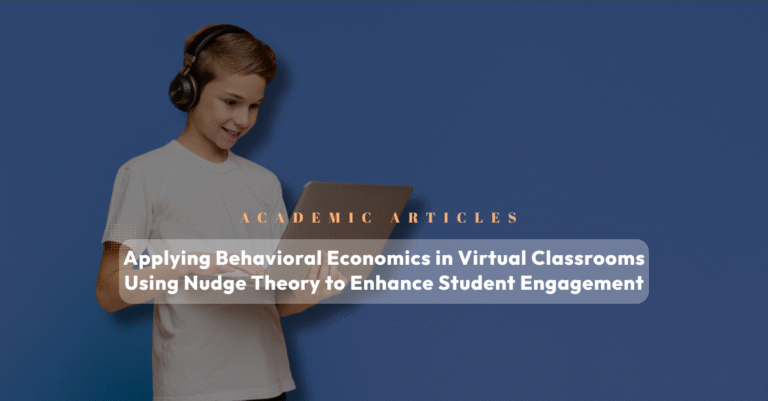While online education offers flexibility and accessibility, it also presents new challenges, particularly when it comes to maintaining student motivation and engagement.
One promising solution lies at the intersection of psychology and economics: Behavioral Economics, Nudge Theory.
Nudge Theory, popularized by Nobel laureate Richard Thaler and legal scholar Cass Sunstein, is based on the idea that small design changes in the environment can influence human behavior in predictable ways, without restricting choice.
These “nudges” can significantly improve student engagement and outcomes in virtual learning environments when applied thoughtfully.
What Is a “Nudge” in Education?
A nudge is a subtle prompt or modification in the learning environment that gently guides students toward better decisions and behaviors. It’s not about forcing or coercing students; it’s about designing digital learning experiences that encourage positive choices—like logging in on time, completing assignments, or participating in discussions—without the need for direct oversight or enforcement.
Behavioral Economics Meets the Virtual Classroom
Here’s how behavioral economics and nudge theory can be harnessed in online education to improve learning outcomes.
Default Settings That Bring Positive Encouragement
In behavioral economics, the default option is often the most powerful nudge.
In virtual classrooms, educators can pre-set helpful defaults that support engagement:
- Auto-enrollment in discussion boards or live sessions.
- Pre-scheduled weekly reminders for quizzes and assignments.
- Auto-subscribe to feedback notifications so students get instant performance updates.
These small design decisions make the desired behaviors easier to follow, without requiring extra effort from students.
Timely Reminders and Notifications

Students often procrastinate not out of laziness, but due to forgetfulness or feeling overwhelmed.
Strategic, personalized email or in-platform reminders can act as timely nudges:
- “You’re 80% done with this week’s module—just one step left!”
- “Only two more quizzes to unlock your weekly badge!”
- “Students who completed this module early scored 15% higher on the final exam.”
These messages use social proof and loss aversion, powerful behavioral motivators, to push students toward action.
Gamification and Reward Framing
Using behavioral framing with gamification, educators can shift how rewards are perceived.
Instead of just showing scores, platforms can present feedback like:
- “Great job! You’re now in the top 20% of your class.”
- “You’re 3 points away from earning your ‘Consistency Streak’ badge.”
- “Missing this deadline could drop your progress by a whole level.”
Such feedback leans on goal gradients, a behavioral principle suggesting that people work harder as they get closer to achieving a goal.
Social Comparison and Peer Influence
Behavioral economics shows that the behavior of others highly influences people.
Virtual classrooms can use this to their advantage by showing anonymized comparisons:
- “80% of students in your group submitted their assignments on time.”
- “Most students watched the lecture within 24 hours—have you?”
This normative feedback leverages peer behavior to nudge lagging students without public shaming.
Commitment Devices and Micro-Goals
Allowing students to make small, voluntary commitments—like setting personal deadlines, choosing peer mentors, or creating a study plan—can boost follow-through. These act as psychological contracts that increase the likelihood of task completion.
Breaking long-term tasks into micro-goals with visible progress bars also uses the Zeigarnik effect (people remember unfinished tasks better than finished ones), keeping students engaged over time.
Simplification and Choice Architecture
Too many options or cluttered interfaces can lead to decision fatigue
Nudge theory recommends simplifying choices:
- Curating one recommended path instead of dozens of content options.
- Highlighting “next best actions” on dashboards.
- Visual cues like arrows or color coding are used to direct focus.
By cleaning up the user interface and minimizing friction, educators help students make better decisions faster.
Real-World Example: Nudging with LMS Features
Many learning management systems (LMS), like Canvas, Moodle, or Google Classroom, already include features that lend themselves to behavioral nudges:
- Conditional release of content (unlocking lessons based on progress).
- Leaderboards or badges for milestones.
- Pop-up reminders for idle users.
Educators and instructional designers can enhance these tools with a behavioral lens, ensuring the digital environment supports rather than hinders engagement.
Final Thoughts: Designing with Empathy and Insight
Applying behavioral economics to virtual learning is not about manipulation but understanding how people behave, especially when distracted, overwhelmed, or unmotivated.
Nudges help create an environment where students are more likely to make decisions that benefit their education.
As online education becomes more prevalent, integrating these subtle, research-based strategies can bridge the engagement gap and empower learners to stay on track, one slight nudge at a time.
Share, Discuss, or Ask
Do you have a child in an online school, or are you considering enrolling your child in one? We’d love to hear about your experiences. Let us know what has been or may be decisive in the dilemma of Traditional vs. Online.
If you have questions, please visit us at EduWW or email [email protected].



